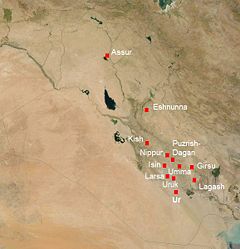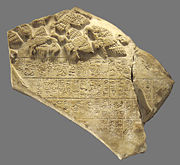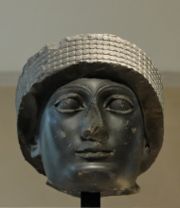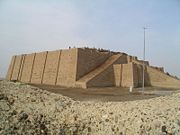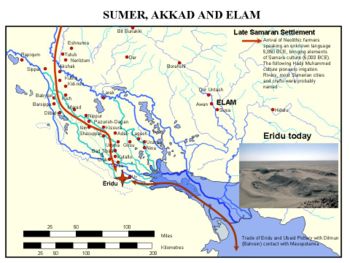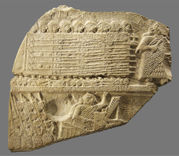Sumer
2008/9 Schools Wikipedia Selection. Related subjects: Ancient History, Classical History and Mythology
| Ancient Mesopotamia |
|---|
 |
| Euphrates · Tigris |
|
Empires / Cities
|
| Sumer |
| Eridu · Kish · Uruk · Ur Lagash · Nippur · Ngirsu |
| Elam |
| Susa |
| Akkadian Empire |
| Akkad · Mari |
| Amorites |
| Isin · Larsa |
| Babylonia |
| Babylon · Chaldea |
| Assyria |
| Assur · Nimrud Dur-Sharrukin · Nineveh |
|
Hittites · Kassites
Hurrians / Mitanni |
|
Chronology
|
| Mesopotamia |
| Sumer ( king list) |
| Kings of Assyria Kings of Babylon |
|
Mythology
|
| Enûma Elish · Gilgamesh |
| Assyro-Babylonian religion |
|
Language
|
| Sumerian · Elamite |
| Akkadian · Aramaic |
| Hurrian · Hittite |
Sumer ( Sumerian: 𒆠𒂗𒂠 ki- en-ĝir15, Akkadian: Šumeru; possibly Biblical Shinar ), located in southern Mesopotamia, is one of the earliest known civilizations in the world. It lasted from the first settlement of Eridu in the Ubaid period (late 6th millennium BC) through the Uruk period (4th millennium BC) and the Dynastic periods (3rd millennium BC) until the rise of Babylon in the early 2nd millennium BC. The term "Sumerian" applies to all speakers of the Sumerian language.
Although other cities pre-date Sumer ( Jericho, Çatalhöyük and others, either for seasonal protection, or as year-round trading posts) the cities of Sumer were the first to practice intensive, year-round agriculture (from ca. 5300 BC). The surplus of storable foodstuffs created by this economy allowed the population to settle in one place instead of migrating after crops and herds. It also allowed for a much greater population density, and in turn required an extensive labor force and division of labor. This organization led to the necessity of record keeping and the development of writing (ca. 3500 BC).
Origin of Name
The term "Sumerian" is the common name given to the ancient inhabitants of southern Mesopotamia by their successors, the Semitic Akkadians. The Sumerians called themselves sag-giga, literally meaning "the black-headed people". The Akkadian word Shumer may represent this name in dialect, but it is unknown why the Akkadians called the southern land Shumeru. Biblical Shinar, Egyptian Sngr and Hittite Šanhar(a) could be western variants of Šumer.
City states
By the late 4th millennium BC, Sumer was divided into about a dozen independent city-states, whose limits were defined by canals and boundary stones. Each was centered on a temple dedicated to the particular patron god or goddess of the city and ruled over by a priestly governor ( ensi) or by a king ( lugal) who was intimately tied to the city's religious rites.
|
The five "first" cities said to have exercized pre-dynastic kingship:
Other principal cities:
(1location uncertain) |
Minor cities (from south to north):
(2an outlying city in northern Mesopotamia) |
Apart from Mari, which lies full 330 km northwest of Agade, but which is credited in the king list as having “exercised kingship” in the Early Dynastic II period, and Nagar, an outpost, these cities are all in the Euphrates-Tigris alluvial plain, south of Baghdad in what are now the Bābil, Diyala, Wāsit, Dhi Qar, Al-Muthannā and Al-Qādisiyyah governorates of Iraq.
History
The Sumerian city states rose to power during the prehistorical Ubaid and Uruk periods. Sumerian history reaches back to the 29th century BC and before, but the historical record remains obscure until the Early Dynastic III period, ca. the 26th century BC, when a now deciphered syllabary writing system was developed, which has allowed archaeologists to read contemporary records and inscriptions. Classical Sumer ends with the rise of the Akkadian Empire in the 23rd century. Following the Gutian period, there is a brief " Sumerian renaissance" in the 21st century, cut short in the 20th century BC by Amorite invasions. The Amorite "dynasty of Isin" persisted until ca. 1700 BC, when Mesopotamia was united under Babylonian rule.
- Ubaid period: 5300 – 4100 BC (Pottery Neolithic to Chalcolithic)
- Uruk period: 4100 – 2900 BC (Late Chalcolithic to Early Bronze Age I)
- Uruk XIV-V: 4100 – 3300 BC
- Uruk IV period: 3300 – 3000 BC
- Jemdet Nasr period (Uruk III): 3000 – 2900 BC
- Early Dynastic period (Early Bronze Age II-IV)
- Early Dynastic I period: 2900 – 2800 BC
- Early Dynastic II period: 2800 – 2600 BC ( Gilgamesh)
- Early Dynastic IIIa period: 2600 – 2500 BC
- Early Dynastic IIIb period: ca. 2500 – 2334 BC
- Akkadian Empire period: ca. 2334 – 2218 BC ( Sargon)
- Gutian period: ca. 2218 – 2047 BC (Early Bronze Age IV)
- Ur III period: ca. 2047 – 1940 BC
Ubaid period
The Ubaid period is marked by a distinctive style of fine quality painted pottery which spread throughout Mesopotamia and the Persian Gulf. During this time, the first settlement in southern Mesopotamia was established at Eridu, ca. 5300 BC, by farmers who brought with them the Samarran culture from northern Mesopotamia. It is not known whether or not these were the actual Sumerians who are identified with the later Uruk culture. Eridu remained an important religious centre when it was gradually surpassed in size by the nearby city of Uruk.
Uruk period
The archaeological transition from the Ubaid period to the Uruk period is marked by a gradual shift from painted pottery domestically produced on a slow wheel, to a great variety of unpainted pottery mass-produced by specialists on fast wheels.
By the time of the Uruk period (ca. 4100 – 2900 BC calibrated), the volume of trade goods transported along the canals and rivers of southern Mesopotamia facilitated the rise of many large stratified, temple-centered cities (with populations of over 10,000 people) where centralized administrations employed specialized workers. It is fairly certain that it was during the Uruk period that Sumerian cities began to make use of slave labor captured from the hill country, and there is ample evidence for captured slaves as workers in the earliest texts. Artifacts, and even colonies of this Uruk civilization have been found over a wide area - from the Taurus Mountains in Turkey, to the Mediterranean Sea in the west, and as far east as Central Iran.
The Uruk period civilization, exported by Sumerian traders and colonists (like that found at Tell Brak), had an effect on all surrounding peoples, who gradually evolved their own comparable, competing economies and cultures. The cities of Sumer could not maintain remote, long-distance colonies by military force.
Sumerian cities during the Uruk period were probably theocratic and were most likely headed by a priest-king (ensi), assisted by a council of elders, including both men and women. It is quite possible that the later Sumerian pantheon was modelled upon this political structure.
| Notable Sumerians History of Sumer • Mythology • King list
|
|
|---|---|
| Pre-dynastic kings: | Alulim • Dumuzid, the Shepherd • En-men-dur-ana |
| 1st Dynasty of Kish: | Etana • En-me-barage-si • Aga of Kish |
| 1st Dynasty of Uruk: | Enmerkar • Lugalbanda • Gilgamesh |
| 1st Dynasty of Ur: | Meskalamdug • Mesh-Ane-pada • Puabi • Mesilim of Kish |
| 2nd Dynasty of Uruk: | En-shag-kush-ana |
| 1st Dynasty of Lagash: | Ur-Nanshe • Eannatum • Entemena • Urukagina |
| Dynasty of Adab: | Lugal-Ane-mundu |
| 3rd Dynasty of Kish: | Kug-Bau |
| 3rd Dynasty of Uruk: | Lugal-zage-si |
| Dynasty of Akkad: | Sargon • En-hedu-ana • Man-ishtishu • Naram-Suen of Akkad • Shar-kali-sharri • Dudu of Akkad • Shu-Durul |
| 2nd Dynasty of Lagash: | Puzer-Mama • Gudea |
| 5th Dynasty of Uruk: | Utu-hengal |
| 3rd dynasty of Ur: | Ur-Namma • Shulgi • Amar-Suena • Shu-Suen • Ibbi-Suen |
The ancient Sumerian king list includes the early dynasties of several prominent cities from this period. The first set of names on the list is of kings said to have reigned before a major flood occurred. These early names may be fictional, and include some legendary and mythological figures, such as Alulim and Dumizid.
The end of the Uruk period coincided with the Piora oscillation, a dry period from c. 3200 – 2900 BC that marked the end of a long wetter, warmer climate period from about 9,000 to 5,000 years ago, called the Holocene climatic optimum.
Early Dynastic Period
The Dynastic period begins ca. 2900 BC and includes such legendary figures as Enmerkar and Gilgamesh—who are supposed to have reigned shortly before the historic record opens ca. 2700 BC, when the now decipherable syllabic writing started to develop from the early pictograms. The centre of Sumerian culture remained in southern Mesopotamia, even though rulers soon began expanding into neighboring areas, and neighboring Semitic groups adopted much of Sumerian culture for their own.
The earliest Dynastic king on the Sumerian king list whose name is known from any other legendary source is Etana, 13th king of the first Dynasty of Kish. The earliest king authenticated through archaeological evidence is Enmebaragesi of Kish (ca. 26th century BC), whose name is also mentioned in the Gilgamesh epic—leading to the suggestion that Gilgamesh himself might have been a historical king of Uruk.
1st Dynasty of Lagash
ca. 2500 – 2270 BC
The dynasty of Lagash, though omitted from the king list, is well attested through several important monuments and many archaeological finds.
Although short-lived, one of the first empires known to history was that of Eannatum of Lagash, who annexed practically all of Sumer, including Kish, Uruk, Ur, and Larsa, and reduced to tribute the city-state of Umma, arch-rival of Lagash. In addition, his realm extended to parts of Elam and along the Persian Gulf. He seems to have used terror as a matter of policy—his stele of the vultures has been found, showing violent treatment of enemies. His empire collapsed shortly after his death.
Later, Lugal-Zage-Si, the priest-king of Umma, overthrew the primacy of the Lagash dynasty in the area, then conquered Uruk, making it his capital, and claimed an empire extending from the Persian Gulf to the Mediterranean. He was the last ethnically Sumerian king before the arrival of the Semitic king, Sargon of Akkad.
Akkadian Empire
ca. 2270 – 2083 BC ( short chronology)
The Semitic Akkadian language is first attested in proper names of the kings of Kish ca. 2800 BC, preserved in later king lists. There are texts written entirely in Old Akkadian dating from ca. 2500 BC. Use of Old Akkadian was at its peak during the rule of Sargon the Great (ca. 2270 – 2215 BC), but even then most administrative tablets continued to be written in Sumerian, the language used by the scribes. Gelb and Westenholz differentiate three stages of Old Akkadian: that of the pre-Sargonic era, that of the Akkadian empire, and that of the " Neo-Sumerian Renaissance" that followed it. Speakers of Akkadian and Sumerian coexisted for about one thousand years, until ca. 1800 BC, when Sumerian ceased to be spoken. Thorkild Jacobsen has argued that there is little break in historical continuity between the pre- and post-Sargon periods, and that too much emphasis has been placed on the perception of a "Semitic vs. Sumerian" conflict. However, it is certain that Akkadian was also briefly imposed on neighboring parts of Elam that were conquered by Sargon.
Gutian period
ca. 2083 – 2050 BC ( short chronology)
2nd Dynasty of Lagash
ca. 2093 – 2046 BC ( short chronology)
Following the downfall of the Akkadian Empire at the hands of Gutians, another native Sumerian ruler, Gudea of Lagash, rose to local prominence and continued the practices of the Sargonid kings' claims to divinity. Like the previous Lagash dynasty, Gudea and his descendents also promoted artistic development and left a large number of archaeological artifacts.
Sumerian renaissance
ca. 2047 – 1940 BC ( short chronology)
Later, the 3rd dynasty of Ur under Ur-Nammu and Shulgi, whose power extended as far as northern Mesopotamia, was the last great "Sumerian renaissance", but already the region was becoming more Semitic than Sumerian, with the influx of waves of Martu ( Amorites) who were later to found the Babylonian Empire. The Sumerian language, however, remained a sacerdotal language taught in schools, in the same way that Latin was used in the Medieval period, for as long as cuneiform was utilised.
Decline
This period is generally taken to coincide with a major shift in population from southern Iraq toward the north. Ecologically, the agricultural productivity of the Sumerian lands was being compromised as a result of rising salinity. Soil salinity in this region had been long recognised as a major problem. Poorly drained irrigated soils, in an arid climate with high levels of evaporation, led to the buildup of dissalved salts in the soil, eventually reducing agricultural yields severely. During the Akkadian and Ur III phases, there was a shift from the cultivation of wheat to the more salt-tolerant barley, but this was insufficient, and during the period from 2100 BC to 1700 BC, it is estimated that the population in this area declined by nearly 3/5ths. This greatly weakened the balance of power within the region, weakening the areas where Sumerian was spoken, and comparatively strengthening those where Akkadian was the major language. Henceforth Sumerian would remain only a literary and liturgical language, similar to the position occupied by Latin in medieval Europe.
Following an Elamite invasion and sack of Ur during the rule of Ibbi-Sin (ca. 1940 BC), Sumer came under Amorite rule (taken to introduce the Middle Bronze Age). The independent Amorite states of the 20th to 18th centuries are summarized as the " Dynasty of Isin" in the Sumerian king list, ending with the rise of Babylonia under Hammurabi ca. 1700 BC.
Population
The Sumerians were a non-Semitic people and were at one time believed to have been invaders, as a number of linguists believed they could detect a substrate language beneath Sumerian. However, the archaeological record shows clear uninterrupted cultural continuity from the time of the Early Ubaid period (5300 – 4700 BC C-14) settlements in southern Mesopotamia. The Sumerian people who settled here farmed the lands in this region that were made fertile by silt deposited by the Tigris and the Euphrates rivers.
Despite the lack of corroborating written records, it is generally agreed that Sumerian speakers were farmers who moved down from the north, after perfecting irrigation agriculture there. The Ubaid pottery of southern Mesopotamia has been connected via Choga Mami Transitional ware to the pottery of the Samarra period culture (c. 5700 – 4900 BC C-14) in the north, who were the first to practice a primitive form of irrigation agriculture along the middle Tigris River and its tributaries. The connection is most clearly seen at Tell Awayli (Oueilli, Oueili) near Larsa, excavated by the French in the 1980s, where 8 levels yielded pre-Ubaid pottery resembling Samarran ware. Farming peoples spread down into southern Mesopotamia because they had developed a temple-centered social organization for mobilizing labor and technology for water control, enabling them to survive and prosper in a difficult environment.
Alternatively, the Sumerians may have been an indigenous culture of hunter-fishers who lived in the reedy marshlands at the mouth of the Tigris and Euphrates Rivers, as the Marsh Arabs do today. This culture contributed to a cultural fusion with northern agriculturists, creating Sumerian language and civilisation.
Culture
Sumerian culture may be traced to two main centers, Eridu in the south and Nippur in the north may be regarded as a contrasting poles of Sumerian religion.
The deity Enlil, around whose sanctuary Nippur had grown up, was considered lord of the ghost-land, and his gifts to mankind were said to be the spells and incantations that the spirits of good or evil were compelled to obey. The world he governed was a mountain (E-kur from E=house and Kur=Mountain); the creatures that he had made lived underground.
Eridu, on the other hand, was the home of the culture god Enki (absorbed into Babylonian mythology as the god Ea), the god of beneficence, ruler of the freshwater depths beneath the earth (the Abzu from Ab=water and Zu=far), a healer and friend to humanity who was thought to have given us the arts and sciences, the industries and manners of civilization; the first law-book was considered his creation. Eridu had once been a seaport, and it was doubtless its foreign trade and intercourse with other lands that influenced the development of its culture. Its cosmology was the result of its geographical position: the earth, it was believed, had grown out of the waters of the deep, like the ever widening coast at the mouth of the Euphrates. Long before history is recorded, however, the cultures of Eridu and Nippur had coalesced. While Babylon seems to have been a colony of Eridu, Eridu's immediate neighbour, Ur, may have been a colony of Nippur, since its moon god was said to be the son of Enlil of Nippur. However, in the admixture of the two cultures, the influence of Eridu was predominant.
Historian Alan Marcus has been quoted as saying that "Sumerians held a rather dour perspective on life." One Sumerian wrote: "Tears, lament, anguish, and depression are within me. Suffering overwhelms me. Evil fate holds me and carries off my life. Malignant sickness bathes me." Another wrote, "Why am I counted among the ignorant? Food is all about, yet my food is hunger. On the day shares were allotted, my allotted share was suffering."
There is much evidence that the Sumerians loved music. It seemed to be an important part of religious and civic life in Sumer. Lyres were popular in Sumer; see Sumerian music.
According to inscriptions describing the reforms of king Urukagina of Lagash (ca. 2300 BC), he is said to have abolished the former custom of polyandry in his country, on pain of the woman taking multiple husbands being stoned with rocks upon which her crime is written.
Though women were protected by late Sumerian law and were able to achieve a higher status in Sumer than in other contemporary civilizations, the culture was male-dominated. The Code of Ur-Nammu, the oldest such codification yet discovered, dating to the Ur-III "Sumerian Renaissance", reveals a glimpse at societal structure in late Sumerian law. Beneath the lu-gal ("great man" or king), all members of society belonged to one of two basic strata: The "lu" or free person, and the slave (male, arad; female geme). The son of a lu was called a dumu-nita until he married. A woman (munus) went from being a daughter (dumu-mi), to a wife (dam), then if she outlived her husband, a widow (numasu) who could remarry.
Language and writing
The most important archaeological discoveries in Sumer are a large number of tablets written in Sumerian. Sumerian pre- cuneiform script has been discovered on tablets dating to around 3500 BC.
The Sumerian language is generally regarded as a language isolate in linguistics because it belongs to no known language family; Akkadian belongs to the Afro-Asiatic languages. There have been many failed attempts to connect Sumerian to other language groups. It is an agglutinative language; in other words, morphemes ("units of meaning") are added together to create words.
Sumerians invented picture- hieroglyphs that developed into later cuneiform, and their language vies with Ancient Egyptian for credit as the oldest known written human language. An extremely large body of hundreds of thousands of texts in the Sumerian language has survived, the great majority of these on clay tablets. Known Sumerian texts include personal and business letters and transactions, receipts, lexical lists, laws, hymns and prayers, magical incantations, and scientific texts including mathematics, astronomy, and medicine. Monumental inscriptions and texts on different objects like statues or bricks are also very common. Many texts survive in multiple copies because they were repeatedly transcribed by scribes-in-training. Sumerian continued to be the language of religion and law in Mesopotamia long after Semitic speakers had become the ruling race.
Understanding Sumerian texts today can be problematic even for experts. Most difficult are the earliest texts, which in many cases don't give the full grammatical structure of the language.
Religion
Like other cities of Asia Minor and the Mediterranean, Sumer was a polytheistic, or henotheistic, society. Their lives were spent serving the gods in the form of man-made statues. There was no organized set of gods; each city-state had its own patrons, temples, and priest-kings. The Sumerians were probably the first to write down their beliefs, which were the inspiration for much of later Mesopotamian mythology, religion, and astrology.
The Sumerians worshipped An as the full time god, equivalent to "heaven"—indeed, the word "an" in Sumerian means "sky." His consort Ki, means "Earth". Collectively the gods were known as Anunna ((d)an-unna = "offspring of the lord"). An's closest cohorts were Enki in the south at the E'abzu temple in Eridu, Enlil in the north at the E'kur temple of Nippur, and Inanna, the deification of Venus, the morning (eastern) and evening (western) star, at the E'anna temple (shared with An) at Uruk. The sun-god Utu was worshipped at Sippar, the moon god Nanna, was worshipped at Ur. These deities were probably the original matrix; there were hundreds of minor deities. The Sumerian gods (Sumerian dingir, plural dingir-dingir or dingir-re-ne) thus had associations with different cities, and their religious importance often waxed and waned with those cities' political power. The gods were said to have created human beings from clay for the purpose of serving them. If the temples/gods ruled each city it was for their mutual survival and benefit—the temples organized the mass labor projects needed for irrigation agriculture. Citizens had a labor duty to the temple which they were allowed to avoid by a payment of silver only towards the end of the third millennium. The temple-centered farming communities of Sumer had a social stability that enabled them to survive for four millennia.
Sumerians believed that the universe consisted of a flat disk enclosed by a tin dome. The Sumerian afterlife involved a descent into a gloomy netherworld to spend eternity in a wretched existence as a Gidim (ghost).
Ziggurats (Sumerian temples) consisted of a forecourt, with a central pond for purification. The temple itself had a central nave with aisles along either side. Flanking the aisles would be rooms for the priests. At one end would stand the podium and a mudbrick table for animal and vegetable sacrifices. Granaries and storehouses were usually located near the temples. After a time the Sumerians began to place the temples on top of multi-layered square constructions built as a series of rising terraces, giving rise to the later Ziggurat style.
Agriculture and hunting
The Sumerians adopted the agricultural mode of life which had been introduced into Lower Mesopotamia and practiced the same irrigation techniques as those used in Egypt. Adams says that irrigation development was associated with urbanization, and that 89% of the population lived in the cities .
They grew barley, chickpeas, lentils, wheat, dates, onions, garlic, lettuce, leeks and mustard. They also raised cattle, sheep, goats, and pigs. They used oxen as their primary beasts of burden and donkeys or equids as their primary transport animal. Sumerians caught many fish and hunted fowl and gazelle.
Sumerian agriculture depended heavily on irrigation. The irrigation was accomplished by the use of shadufs, canals, channels, dykes, weirs, and reservoirs. The frequent violent floods of the Tigris, and less so, of the Euphrates, meant that canals required frequent repair and continual removal of silt, and survey markers and boundary stones continually replaced. The government required individuals to work on the canals in a corvee, although the rich were able to exempt themselves.
After the flood season and after the Spring Equinox and the Akitu or New Year Festival, using the canals, farmers would flood their fields and then drain the water. Next they let oxen stomp the ground and kill weeds. They then dragged the fields with pickaxes. After drying, they plowed, harrowed, and raked the ground three times, and pulverized it with a mattock, before planting seed. Unfortunately the high evaporation rate resulted in a gradual increase in the salinity of the fields. By the Ur III period, farmers had switched from wheat to the more salt-tolerant barley as their principal crop.
Sumerians harvested during the dry fall season in three-person teams consisting of a reaper, a binder, and a sheaf arranger. The farmers would use threshing wagons to separate the cereal heads from the stalks and then use threshing sleds to disengage the grain. They then winnowed the grain/chaff mixture.
Architecture
The Tigris-Euphrates plain lacked minerals and trees. Sumerian structures were made of plano-convex mudbrick, not fixed with mortar or cement. Mud-brick buildings eventually deteriorate, so they were periodically destroyed, leveled, and rebuilt on the same spot. This constant rebuilding gradually raised the level of cities, which thus came to be elevated above the surrounding plain. The resultant hills, known as tells, are found throughout the ancient Near East.
The most impressive and famous of Sumerian buildings are the ziggurats, large layered platforms which supported temples. Some scholars have theorized that these structures might have been the basis of the Tower of Babel described in Genesis. Sumerian cylinder seals also depict houses built from reeds not unlike those built by the Marsh Arabs of Southern Iraq until as recently as 400 AD. The Sumerians also developed the arch, which enabled them to develop a strong type of roof called a dome. They built this by constructing several arches.
Sumerian temples and palaces made use of more advanced materials and techniques, such as buttresses, recesses, half columns, and clay nails.
Economy and trade
Discoveries of obsidian from far-away locations in Anatolia and lapis lazuli from northeastern Afghanistan, beads from Dilmun (modern Bahrain), and several seals inscribed with the Indus Valley script suggest a remarkably wide-ranging network of ancient trade centered around the Persian Gulf.
The Epic of Gilgamesh refers to trade with far lands for goods such as wood that were scarce in Mesopotamia. In particular, cedar from Lebanon was prized.
The Sumerians used slaves, although they were not a major part of the economy. Slave women worked as weavers, pressers, millers, and porters.
Sumerian potters decorated pots with cedar oil paints. The potters used a bow drill to produce the fire needed for baking the pottery. Sumerian masons and jewelers knew and made use of alabaster (calcite), ivory, gold, silver, carnelian and lapis lazuli.
Military
The almost constant wars among the Sumerian city-states for 2000 years helped to develop the military technology and techniques of Sumer to a high level. The first war recorded was between Lagash and Umma in ca. 2525 BC on a stele called the Stele of Vultures. It shows the king of Lagash leading a Sumerian army consisting mostly of infantry. The infantrymen carried spears, wore copper helmets and carried leather or wicker shields. The spearmen are shown arranged in what resembles the phalanx formation, which requires training and discipline; this implies that the Sumerians may have made use of professional soldiers.
The Sumerian military used carts harnessed to onagers. These early chariots functioned less effectively in combat than did later designs, and some have suggested that these chariots served primarily as transports, though the crew carried battle-axes and lances. The Sumerian chariot comprised a four or two-wheeled device manned by a crew of two and harnessed to four onagers. The cart was composed of a woven basket and the wheels had a solid three-piece design.
Sumerian cities were surrounded by defensive walls. The Sumerians engaged in siege warfare between their cities, but the mudbrick walls failed to deter some foes.
Technology
Examples of Sumerian technology include: the wheel, cuneiform, arithmetic and geometry, irrigation systems, Sumerian boats, lunisolar calendar, bronze, leather, saws, chisels, hammers, Brace (tool)s, bits, nails, pins, rings, hoes, axes, knives, lancepoints, arrowheads, swords, glue, daggers, waterskins, bags, harnesses, armor, quivers, war chariots, scabbards, boots, sandals and harpoons.
The Sumerians had three main types of boats:
- clinker-built sailboats stitched together with hair, featuring bitumen waterproofing
- skin boats comprising of animal skins and reeds
- wooden-oared ships, sometimes pulled upstream by people and animals walking along the nearby banks
Legacy
Most authorities credit the Sumerians with the invention of the wheel, initially in the form of the potter's wheel. The new concept quickly led to wheeled vehicles and mill wheels. The Sumerians' cuneiform writing system is the oldest for which there is evidence (excluding proto-writing such as the Vinča signs and the even older Jiahu signs). The Sumerians were among the first astronomers, mapping the stars into sets of constellations, many of which survived in the zodiac and were also recognized by the ancient Greeks. The five planets that are visible to the naked eye have Sumerian names.
They invented and developed arithmetic using several different number systems including a Mixed radix system with an alternating base 10 and base 6. This sexagesimal system became the standard number system in Sumer and Babylonia. They may have invented military formations and introduced the basic divisions between infantry, cavalry and archers. They developed the first known codified legal and administrative systems, complete with courts, jails, and government records. The first true city states arose in Sumer, roughly contemporaneously with similar entities in what is now Syria and Israel. Several centuries after the invention of cuneiform, the use of writing expanded beyond debt/payment certificates and inventory lists to be applied for the first time, about 2600 BC, to messages and mail delivery, history, legend, mathematics, astronomical records and other pursuits. Conjointly with the spread of writing, the first formal schools were established, usually under the auspices of a city-state's primary temple.
Finally, the Sumerians ushered in the age of intensive agriculture and irrigation. Emmer wheat, barley, sheep (starting as moufflon) and cattle (starting as aurochs) were foremost among the species cultivated and raised for the first time on a grand scale.
